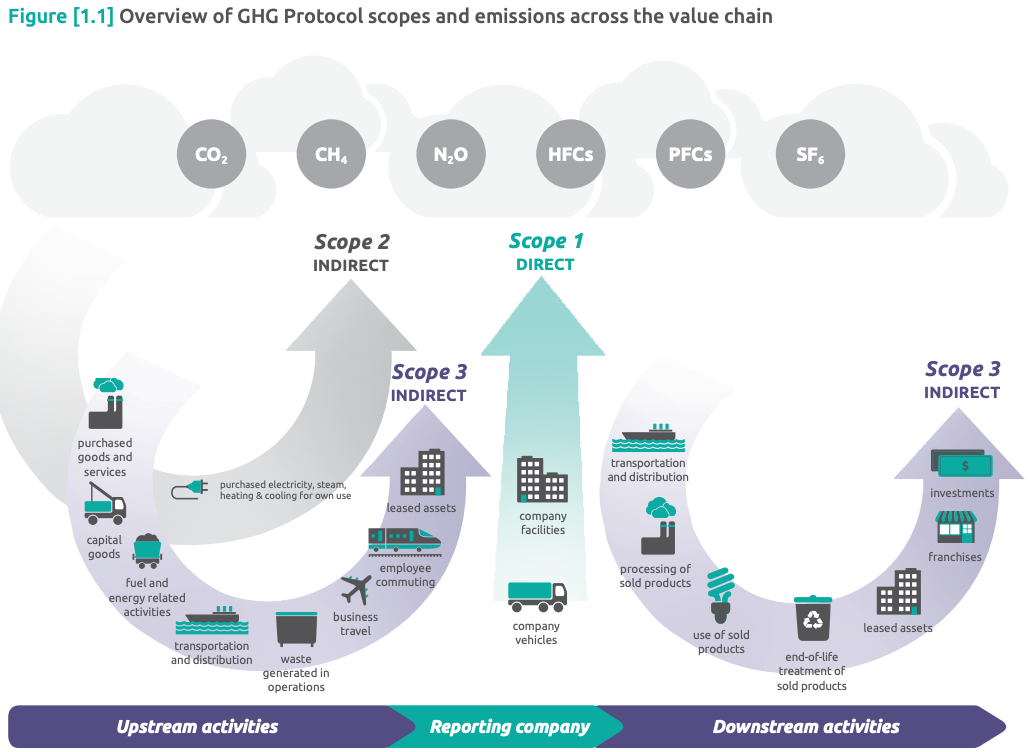GHG Scope 3 Emissions
Introduction
The GHG Protocol is a set of standards to measure and manage greenhouse gas emissions. It helps companies build reports about their environmental impact.
 Source: GHG Procotol Diagram of scopes and emissions across the value chain
Source: GHG Procotol Diagram of scopes and emissions across the value chain
In particular, in the Scope 3, several subcategories are related to mobility: that's where EcoMobiCoin can help!
Scope 3 evaluation
Business travel
Description:
Transportation of employees for business-related activities during the reporting year (in vehicles not owned or operated by the reporting company)
Minimum boundary:
The scope 1 and scope 2 emissions of transportation carriers that occur during use of vehicles (e.g., from energy use) Optional: The life cycle emissions associated with manufacturing vehicles or infrastructure
This category includes emissions from the transportation of employees for business-related activities in vehicles owned or operated by third parties, such as aircraft, trains, buses, and passenger cars. Emissions from transportation in vehicles owned or controlled by the reporting company are accounted for in either scope 1 (for fuel use) or scope 2 (for electricity use). Emissions from leased vehicles operated by the reporting company not included in scope 1 or scope 2 are accounted for in scope 3, category 8 (Upstream leased assets). Emissions from transportation of employees to and from work are accounted for in scope 3, category 7 (Employee commuting). Emissions from business travel may arise from: • Air travel • Rail travel • Bus travel • Automobile travel (e.g., business travel in rental cars or employee-owned vehicles other than employee commuting to and from work) • Other modes of travel Companies may optionally include emissions from business travelers staying in hotels. A reporting company’s scope 3 emissions from business travel include the scope 1 and scope 2 emissions of transportation companies (e.g., airlines).
Example of primary data:
- Activity-specific data from transportation suppliers (e.g., airlines)
- Carrier-specific emission factors
Examples of secondary data:
- Estimated distance traveled based on industry-average data
Employee commuting
Description:
Transportation of employees between their homes and their worksites during the reporting year (in vehicles not owned or operated by the reporting company)
Minimum boundary:
The scope 1 and scope 2 emissions of employees and transportation providers that occur during use of vehicles (e.g., from energy use) Optional: Emissions from employee teleworking
This category includes emissions from the transportation of employees between their homes and their worksites. Emissions from employee commuting may arise from: • Automobile travel • Bus travel • Rail travel • Air travel • Other modes of transportation Companies may include emissions from teleworking (i.e., employees working remotely) in this category. A reporting company’s scope 3 emissions from employee commuting include the scope 1 and scope 2 emissions of employees and third-party transportation providers. Even though employee commuting is not always purchased or reimbursed by the reporting company, it is categorized as an upstream scope 3 category because it is a service that enables company operations, similar to purchased or acquired goods and services.
Example of primary data:
- Specific distance traveled and mode of transport collected from employees
Examples of secondary data:
- Estimated distance traveled based on industry-average data
Notes
- The GHG Protocol is the international standard, but we can also refer to ISO 14064 and ISO 14069
- Before measuring those 2 sub-categories, please follow the associated methodology to ensure you focus on the most significant sources of emissions
Advantages
When using EcoMobiCoin to gather your business travels and commuting data, it gives:
- Transparency
- Accountability
- Security
- Privacy